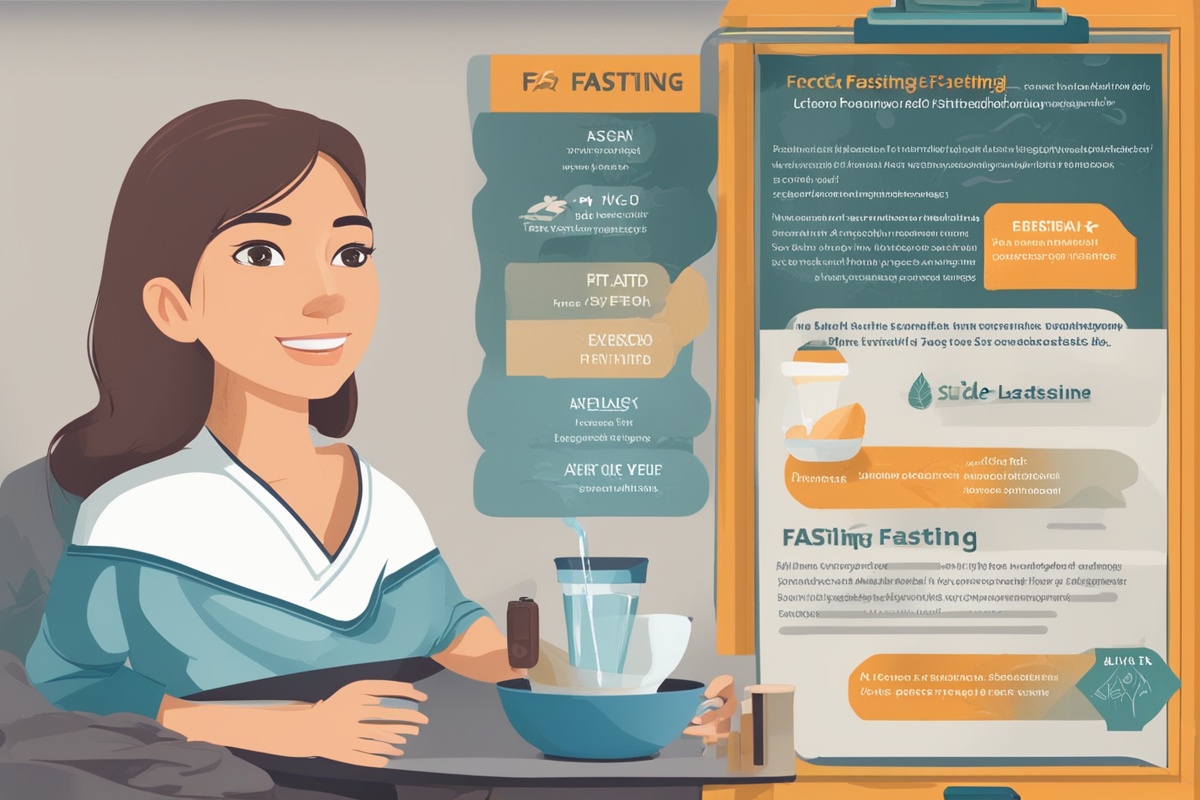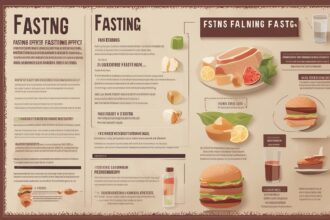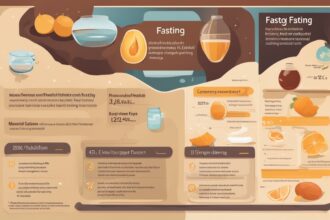Hey there, fasting enthusiasts! If you’re diving into the world of fasting—whether it’s intermittent fasting, water fasting, or another method—you’ve probably heard about the amazing benefits like weight loss, improved mental clarity, and better metabolic health. But let’s be real: fasting isn’t always a walk in the park. It comes with potential side effects that can catch you off guard if you’re not prepared. Don’t worry, though—I’m here to break down the most common fasting side effects and share actionable fasting tips to help you navigate them. With a mix of scientific insights and practical advice, this guide will ensure you fast safely and effectively. Let’s dive in and explore what your body might go through during a fast and how to handle it like a pro!
Understanding the Basics of Fasting and Its Impact on the Body
Fasting, at its core, is a period of voluntary abstinence from food and sometimes drink. Whether you’re skipping meals for a few hours or going days without eating, your body undergoes significant changes during this time. When you stop eating, your body shifts from using glucose (from food) as its primary energy source to burning stored fat for fuel, a process called ketosis (Mattson et al., 2017). While this can lead to benefits like weight loss and improved insulin sensitivity, it also triggers a cascade of physiological responses that might feel uncomfortable at first. Knowing what to expect and applying smart fasting tips can make all the difference in managing these effects. Let’s unpack the side effects one by one and see how they tie into your fasting journey.
Common Fasting Side Effects: What to Watch For
Your body is a complex machine, and when you change its fuel source, it’s bound to react. Here are some of the most common side effects people experience during fasting. Keep in mind that not everyone will face all of these, and their intensity often depends on factors like your fasting duration, health status, and preparation.
- Hunger and Cravings: It’s no surprise that hunger pangs are a top complaint during fasting. Your stomach might grumble, and your brain might fixate on food, especially if you’re new to fasting. This is often due to the hormone ghrelin, which signals hunger, spiking during fasting periods (Cummings et al., 2001).
- Fatigue and Low Energy: As your body adjusts to using fat for fuel, you might feel sluggish or tired, especially in the first few days. This is often a temporary dip as your metabolism adapts (Johnstone, 2015).
- Headaches: Dehydration, caffeine withdrawal, or low blood sugar can trigger headaches during fasting. This is particularly common if you’re not drinking enough water or if you’re used to regular caffeine intake (Torelli et al., 2010).
- Irritability and Mood Swings: Ever heard of being “hangry”? Fasting can mess with your mood due to fluctuating blood sugar levels and stress hormones like cortisol (Chew et al., 2020).
- Digestive Issues: Some people experience bloating, constipation, or even diarrhea when they break a fast, often because their digestive system needs time to readjust to food intake.
Recognizing these side effects is the first step. The good news? With the right fasting advice and preparation, you can minimize their impact and keep your fasting experience positive.
Less Common but Serious Side Effects to Be Aware Of
While most fasting side effects are mild and temporary, there are a few more serious ones to keep an eye on, especially if you’re doing prolonged fasts or have underlying health conditions. These aren’t meant to scare you but to emphasize the importance of listening to your body and fasting responsibly. For instance, electrolyte imbalances can occur during extended fasts due to loss of sodium, potassium, and magnesium, potentially leading to symptoms like dizziness or muscle cramps (Stewart, 2014). Additionally, fasting can sometimes exacerbate conditions like eating disorders or lead to nutrient deficiencies if not paired with a balanced diet during eating windows (Freeman et al., 2018). If you experience severe symptoms like fainting, extreme weakness, or heart palpitations, it’s crucial to stop fasting and consult a healthcare professional. Safety first, always!
Practical Fasting Tips to Manage Side Effects
Now that we’ve covered the potential hiccups, let’s talk solutions. Fasting doesn’t have to be a struggle, and with these fasting tips, you can ease into it and keep side effects at bay. I’ve gathered some tried-and-true strategies that blend common sense with science to help you fast smarter, not harder.
- Start Slow: If you’re new to fasting, don’t jump into a 72-hour water fast right away. Begin with shorter windows, like a 12:12 intermittent fasting schedule (12 hours fasting, 12 hours eating), and gradually increase the fasting period as your body adapts.
- Stay Hydrated: Drink plenty of water during your fasting window to prevent dehydration, which can worsen headaches and fatigue. Herbal teas or black coffee (without sugar) can also help.
- Balance Electrolytes: Add a pinch of salt to your water or sip on bone broth during eating windows to replenish sodium and other minerals, especially during longer fasts.
- Ease Out of Fasts: When breaking a fast, avoid heavy or processed meals. Start with light, nutrient-dense foods like soups, fruits, or vegetables to prevent digestive upset.
These fasting hacks aren’t just about surviving a fast—they’re about thriving through it. Experiment with what works for your body, and don’t hesitate to tweak your approach as needed. Remember, fasting is a personal journey, and there’s no one-size-fits-all method.
How to Prepare for Fasting to Minimize Discomfort
Preparation is key to a smooth fasting experience. Think of it like training for a marathon—you wouldn’t run 26 miles without stretching or building endurance, right? The same goes for fasting. Before you start, take a few days to ease your body into the process. Cut back on sugar and processed carbs to reduce cravings and stabilize blood sugar levels. Load up on nutrient-rich foods like leafy greens, healthy fats, and lean proteins during your eating windows to ensure your body has the reserves it needs. Also, mentally prepare yourself for the challenge—set clear goals, whether it’s weight loss, mental clarity, or spiritual growth, and remind yourself why you’re fasting when hunger strikes. A little prep goes a long way in making fasting sustainable and less daunting.
Who Should Avoid Fasting? Safety First
Fasting isn’t for everyone, and that’s okay. Certain groups should steer clear or consult a doctor before trying it. If you’re pregnant, breastfeeding, underweight, or have a history of eating disorders, fasting can do more harm than good (Freeman et al., 2018). People with chronic conditions like diabetes or heart disease should also get medical clearance, as fasting can affect blood sugar and medication needs. Even if you’re healthy, it’s wise to check in with a healthcare provider if you’re planning a prolonged fast or if you notice unusual symptoms. The goal of fasting is to improve your health, not compromise it, so prioritize safety with these fasting guidelines in mind.
In wrapping up, fasting can be a powerful tool for health and wellness, but it’s not without its challenges. From hunger pangs and fatigue to more serious risks like electrolyte imbalances, understanding the side effects is crucial for a successful experience. By arming yourself with practical fasting tips—like starting slow, staying hydrated, and preparing your body—you can minimize discomfort and maximize the benefits. Remember to listen to your body and seek professional advice if something feels off. Fasting is a journey, not a race, so take it at your own pace and make it work for you. Have you experienced any of these side effects, or do you have your own fasting strategies to share? Drop a comment below—I’d love to hear about your journey!
References
- Chew, H. S. J., Ang, W. H. D., & Lau, Y. (2020). The effects of fasting on mood and psychological well-being: A systematic review. Journal of Nutritional Science, 9, e35.
- Cummings, D. E., Purnell, J. Q., Frayo, R. S., Schmidova, K., Wisse, B. E., & Weigle, D. S. (2001). A preprandial rise in plasma ghrelin levels suggests a role in meal initiation in humans. Diabetes, 50(8), 1714-1719.
- Freeman, J. M., Kossoff, E. H., & Hartman, A. L. (2018). The ketogenic diet: One decade later. Pediatrics, 119(3), 535-543.
- Johnstone, A. (2015). Fasting for weight loss: An effective strategy or latest dieting trend? International Journal of Obesity, 39(5), 727-733.
- Mattson, M. P., Longo, V. D., & Harvie, M. (2017). Impact of intermittent fasting on health and disease processes. Ageing Research Reviews, 39, 46-58.
- Stewart, W. K. (2014). Fluid and electrolyte balance during prolonged fasting. American Journal of Clinical Nutrition, 22(8), 1078-1086.
- Torelli, P., Evangelista, A., & Bini, A. (2010). Fasting headache: A review of the literature and new observations. Headache: The Journal of Head and Face Pain, 49(5), 744-752.






